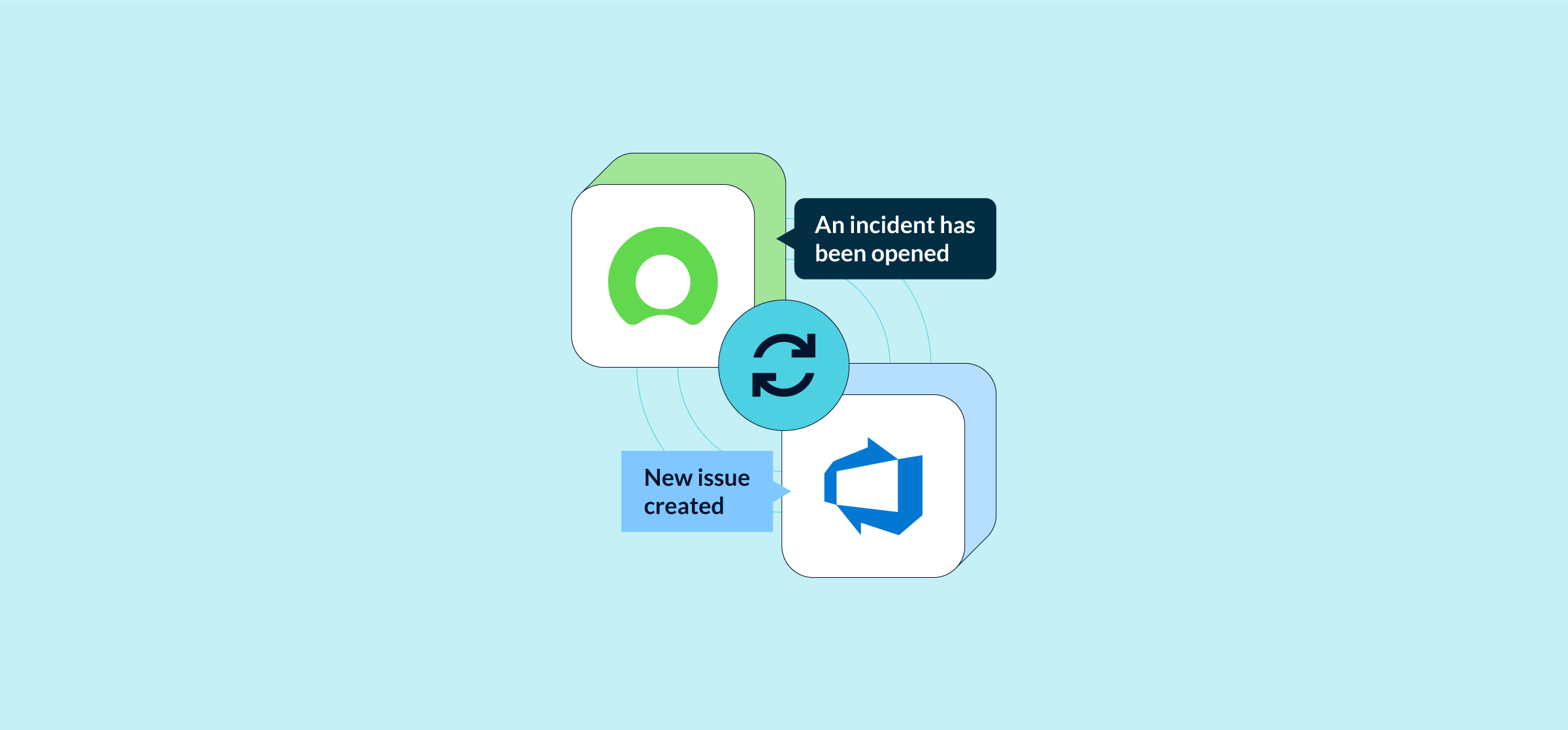Optimizing Incident Management and IT Workflows with a ServiceNow Azure DevOps Integration
The difference between a low-code integration and a custom, fully-coded solution is massive, particularly for IT departments managing incidents for enterprise-level organizations. The tools you’re likely connecting are massive data hubs which keep your entire business interconnected and running smoothly. Interrupting service for any of those tools is a non-starter. That’s not to mention the maintenance cost of keeping code up-to-date with any changes your teams require.
If you’re reading an article about ServiceNow and Azure DevOps, you already know that maintaining any code over a period of time (months, years, decades) can become a burden. However, those issues compound when you have other teams working in a separate tool such as Microsoft Azure DevOps(ADO). Luckily, Unito’s low-code 2-way integration for ADO and ServiceNow can simplify this process. You simply select the fields you need to sync and launch.
This article will guide you through use cases, tips, takeaways, and ideas to inspire smoother integration between ServiceNow and Microsoft Azure DevOps.

Key Takeaways
- Unito’s ServiceNow Azure DevOps integration facilitates and expedites incident management through a low-code 2-way sync. Collaboration between tools and teams is simplified and automated thanks to real-time data updates end-to-end as changes are made in either ServiceNow or Azure DevOps.
- Core advantages of this integration include a reduction in manual effort and error, faster bulk imports or exports, in-depth field configuration (with more flexibility and options than a professional services implementation), as well as automated incident tracking or ticket management.
- Connecting ServiceNow with Azure DevOps via Unito can deliver substantial benefits including an average ROI of 4.7x*, potentially thousands of hours saved per year, improved visibility within IT infrastructures, and smoother customer service experiences.
In this article:
- Challenges in enterprise-level incident management
- A 2-way ServiceNow Azure DevOps integration
- Use cases for a ServiceNow Azure DevOps integration
- The Integration Solution for Real-time Data Syncing
- Watch a product demo sync ADO and ServiceNow
- Summary
- FAQ
Challenges in enterprise-level incident management
Cybersecurity threats
First, what’s at risk for these types of organizations? According to IBM’s cost of breach report, the average cost of a data breach reached an all-time high of USD 4.45 million in 2023. 51% of respondents in that study stated they planned to invest more in data security as a result of experiencing a breach. It goes without saying the time to invest in data security is before you need it, not after.
An effective, operational incident management process is like a fire drill for your IT systems. It involves having the right processes in place to log activity in your system, and using the right software to track issues on an ongoing basis. This helps you identify and solve problems quickly as well as prevent similar problems in the future.

Prevention, process, prioritization
While prevention is key, it’s not always possible. So the second best approach is to develop a fast, responsive incident management and resolution process. You need to know how to prioritize tickets and have a system in place to dispatch support requests quickly and effectively. The faster you can get the right information into the right hands at every level of urgency, the better off your entire organization will be.
Every time a request comes in from another department to update some functionality or address even a basic office supply request, someone has to review each ticket. That process takes time, and if there’s an urgent request lost in the backlog, that time comes with a financial cost.
Upkeep and maintenance of integrations
ADO is preferred by software developers and programmers for managing development workflows including planning, testing and deployment. While you can connect Azure Pipelines with ServiceNow DevOps, it’s designed to suit change requests, rather than incident management. So in order to integrate for incidents, you’ll need to pursue other alternatives. The configuration for the Azure DevOps spoke in ServiceNow is complex, to say the least, and costly.
Just the upkeep involved requires constant time and resources to maintain and issues only grow exponentially unless you scrap it all and start over. But unfortunately, in a large enterprise business (possibly using proprietary or legacy software) that’s rarely an option.
Best practices for incident management in ServiceNow
You have to carefully assess each piece of the puzzle you’ve assembled and make sure nothing breaks when you move them around. But that’s the price you pay to operate a versatile incident management giant such as ServiceNow.
According to ServiceNow, the best practice for managing incident resolution is to:
- Log everything with detailed notes.
- Notify the right people at the right time in order to escalate tickets when necessary.
- Classify every possible incident with precision and follow the same workflow across the IT department.
- Prioritize the most critical incidents first – and be sure to tie potential cost/loss to your prioritization methodology.
- Investigate with a triage team to determine whether or not additional resources are necessary.
- Resolve quickly with procedure and practice. Apply automation (or integration) as needed to expedite this process.
That last note about resolution is particularly crucial if you have teams in multiple tools, such as ServiceNow and Azure DevOps.

Staying flexible and responsive with ITSM
For an efficient handling of unexpected system disturbances throughout all stages of the life cycle associated with such events — scalable, adjustable, easily molded — incident management software becomes indispensable.
After all, If you don’t have access to comprehensive data, how can you prioritize incident response?
DevOps: Focuses on collaboration and automation between development and operations teams. Their goal? Delivering high-quality software quickly and reliably.
DevSecOps: Expands on DevOps by weaving security into the entire software development lifecycle. It’s about building security in from the start, not as an afterthought.

A 2-way ServiceNow Azure DevOps integration
Another alternative to expensive spokes or custom solutions is to connect Azure DevOps (ADO) and ServiceNow with Unito to align IT departments and engineering teams, especially when handling internal tickets that require coordination between different departments.
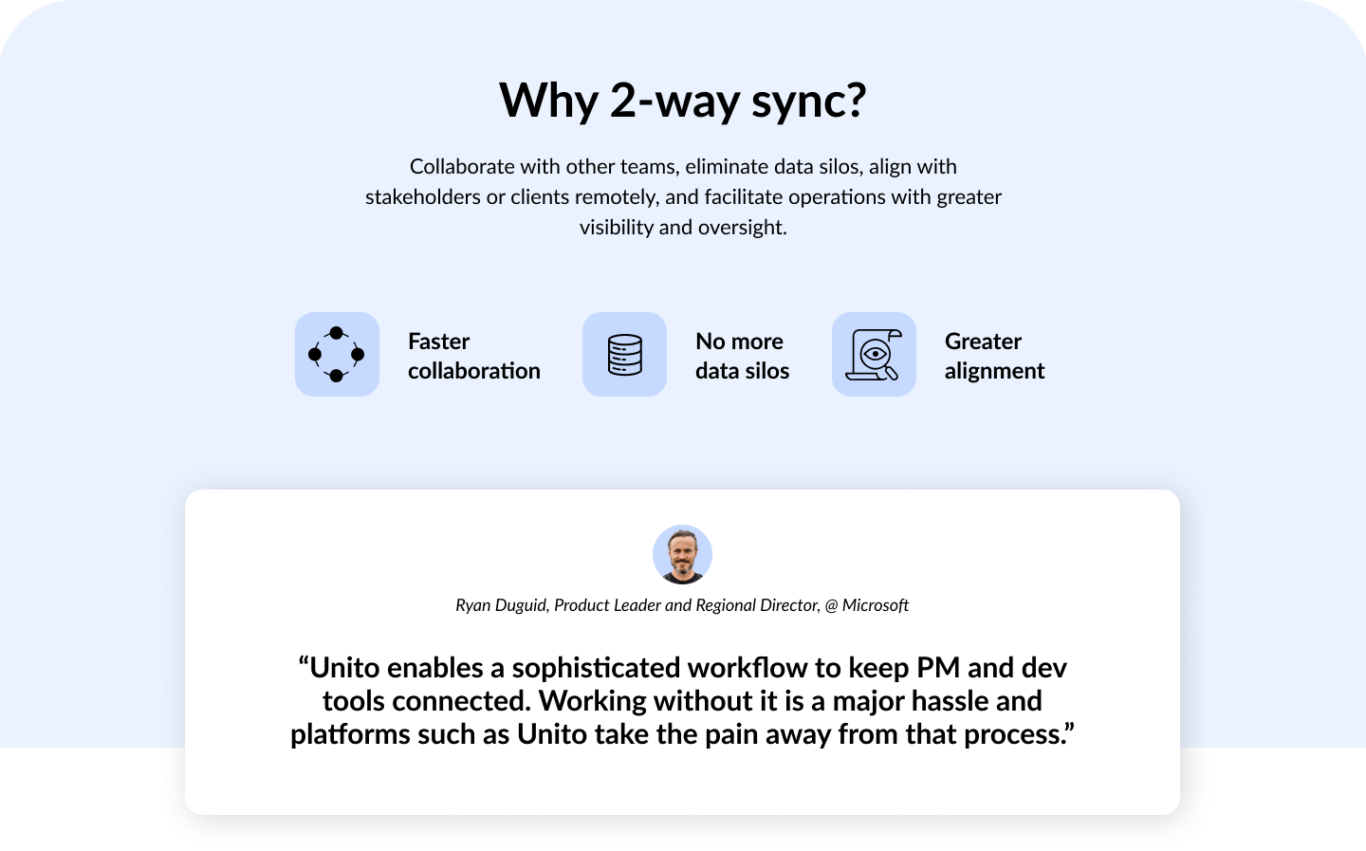
Flexible functionality between incidents and work items
Unito’s integration platform enables bidirectional syncing that turns Azure DevOps work items into ServiceNow records and vice versa. This functionality goes above and beyond what most users experience, even when their instances are implemented by professional service teams. Instead of dealing with a rigid integration of pre-selected options, Unito is no-code, yet fully configurable at any time so your team can adapt as needed.
This new degree of flexibility paves the way for seamless teamwork across departments, covering scenarios such as incorporating Azure DevOps workflows into your ITSM practices, vice versa, or even merging both into a unified system.
Align between teams and tools with real-time updates
A pivotal feature of this connection is Unito’s real-time updates of information as changes in one tool are mirrored to the other while you work. Thus, anyone granted permission can maintain consistency and timeliness within either ServiceNow and Azure DevOps environments.
Such an integration plays a critical role in fortifying cooperation between IT service teams and those manning the service desk—particularly when dealing with internal tickets necessitating collaborative action from diverse sectors within an organization.

Do you need help aligning your marketing and IT teams on common business goals?
Our team interviewed nearly two dozen senior executives from organizations including LinkedIn, Salesforce, Meta, HubSpot, and many more. Get their insights, advice, and best practices on how to align departments on shared business goals in our free eBook.

Use cases for integrating Azure DevOps and ServiceNow
Here are examples of how Unito can support incident resolution for IT and engineering teams.
ITSM Incident management
Improve the quality of your service by reducing internal misalignment. Updates to ServiceNow incidents appear in Azure DevOps work items and vice-versa as teams collaborate between tools. Everyone can review incidents at the right time and with the correct information from end-to-end.
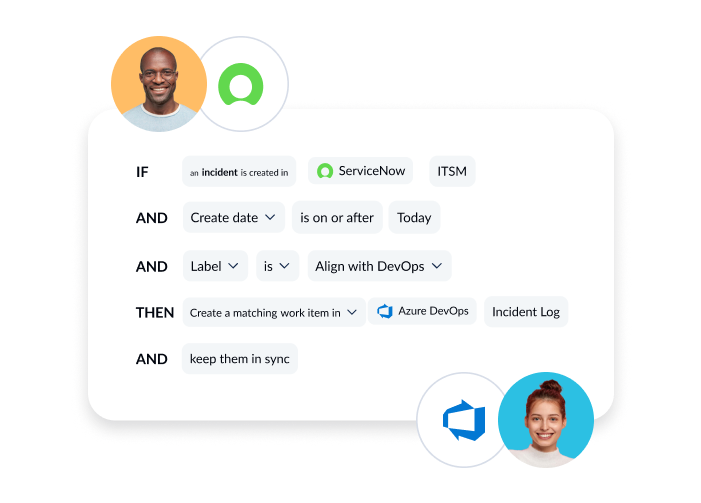
Change management
IT changes are executed precisely with adherence to organizational standards. If you have Azure DevOps work items related to feature requests, releases, or new updates, you can sync them to ServiceNow incidents to ensure any IT change follows your business’s change management process.
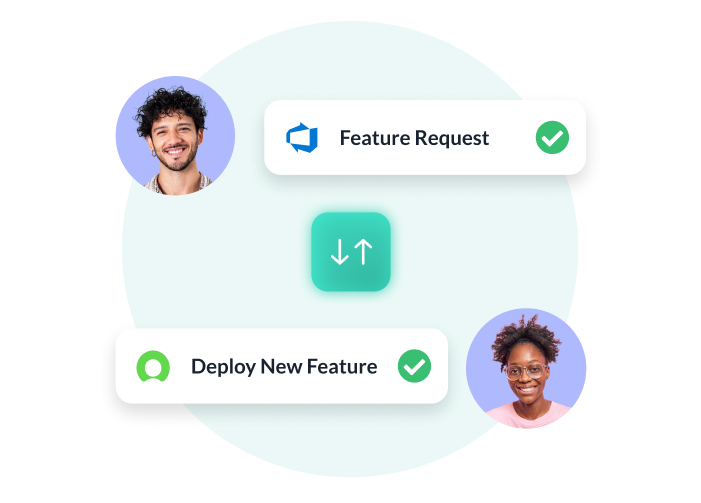
Service request fulfillment
Align on service requests between departments to enable swift action and updates. Unito speeds up incident resolution by keeping teams in touch with real-time information. The net result? Happier customers and greater user satisfaction through an efficient and effective service delivery.

The Integration Solution for Real-time Data Syncing
Unito enables a real-time connection between ServiceNow and Azure DevOps so that updates between tools are always in sync end-to-end. Any changes made in one tool are reflected immediately in the other.
Setting up these integrations is remarkably user-friendly with Unito, taking on average just 12 minutes to complete—accessibility guaranteed even for those without deep technical knowledge.
Key benefits of integrating ServiceNow and ADO with Unito
Users have the capability to configure their data synchronizations through detailed field mappings and adaptable rules tailored to meet distinct workflow needs, thereby increasing efficiency by minimizing manual interventions and reducing errors while facilitating broader tool adoption within a company.
The perks of using Unito’s services for ITSM include:
- A drop in both manual labor requirements and inaccuracies, driven by smoother collaboration between IT service teams and engineering teams.
- Efficient tracking and management of incidents and development tasks.
- Enhanced visibility and transparency across departments, ensuring timely resolution of issues.
Unito reduces the risk of manual input and error in ITSM
Unito’s integration serves as a significant advantage by diminishing the necessity for manual work and decreasing mistakes. This automation in syncing data minimizes human involvement, fostering more effective sharing and processing of information across different divisions.
Enhancing Visibility and Transparency
Automating communications between native systems ensures ongoing transparency while providing stakeholders with up-to-the-minute notifications during ticket resolution. This supports a uniform flow of information. By consolidating workflow data, there is less reliance on an overabundance of emails or Slack messages. Real-time updates relayed via a central master board empower stakeholders to independently keep abreast with project developments in terms of reporting.
Efficient incident management and tracking
The core of Unito’s integration relies heavily on proficient monitoring and administration, where its automated data synchronization capabilities like two-way sync, real-time sync, and historical data sync are key to improving the handling of incidents and tasks.
With intricate field configuration options and the ability to synchronize comments, organizations can configure their tracking procedures to meet particular requirements while ensuring that essential information including tags, people assigned to tasks, commentary threads, and unique fields remain consistent across both platforms.
The process of transferring large quantities of records is simplified through bulk imports along with a reciprocal syncing mechanism for issues as well as cards which enhances consolidation efforts while providing quick access to recent changes. This considerably reduces time consumption and labor for agile software development teams making Unito’s tools an invaluable asset for adept management practices related to tracking activities.
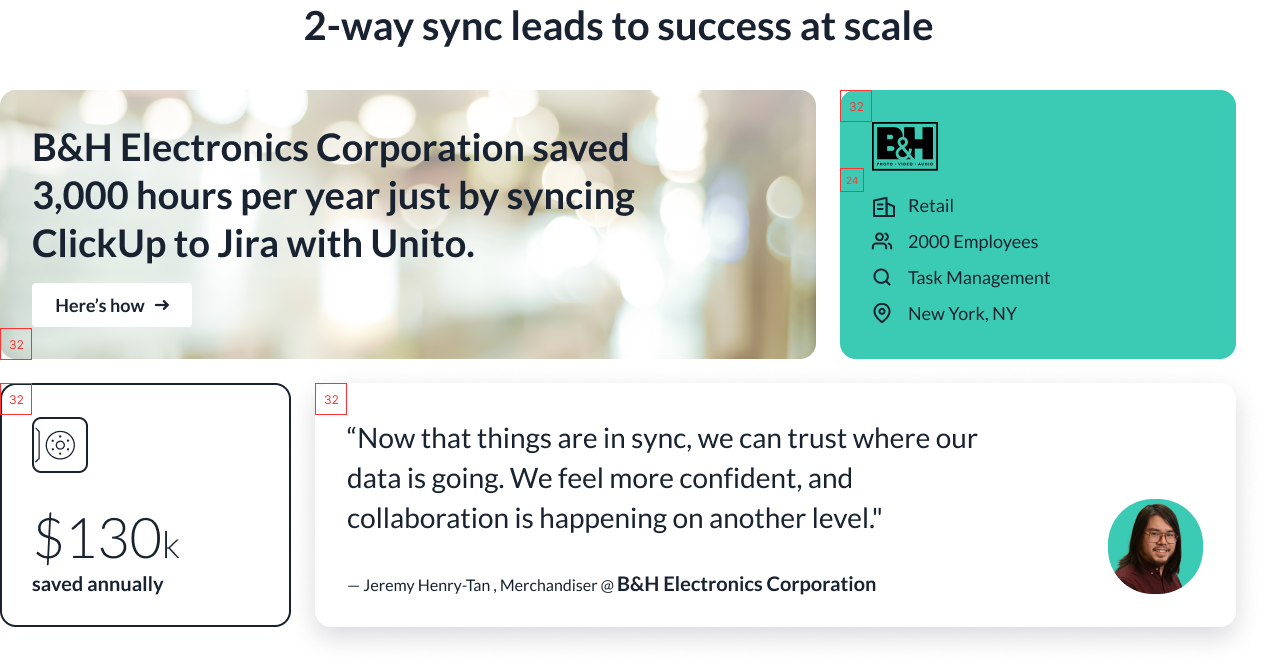
Summary
Enterprise-level IT and engineering teams face significant challenges, especially when collaborating interdepartmentally. Unito’s integration solution for ServiceNow and Azure DevOps emerges as a game-changer in this scenario.
Offering seamless collaboration, efficient tracking, reduced manual effort, and enhanced visibility, Unito’s integration solution addresses pain points in complex workflows and presents a strong value proposition. So whether you are grappling with incident management or looking to streamline workflows, Unito’s integration solution is indeed a silver lining in the cloud of IT challenges.
Addressing Pain Points in Complex Workflows
Intricate workflows often present their own unique complications. Removing one part of the puzzle may cause another to collapse. Each change could lead to unexpected dominos falling over. That’s the danger of relying on a heavily coded instance, particularly as more and more time goes by and staff turnover takes its toll.
As a countermeasure, Unito’s integration solution optimizes the flow of work between different departments by eliminating the need for repetitive data entry tasks. By conducting trial runs and assessing synchronization settings before they go live, both precision and reliability are upheld in tracking and establishing these processes.
Frequently asked questions
Are there alternatives to this Azure DevOps integration with ServiceNow?
Certainly, ServiceNow’s integration hub is capable of automating Azure DevOps work items and establishing connections with additional DevOps tools. ServiceNow’s DevOps application can be found in the Visual Studio Marketplace as part of Extensions for Azure DevOps.

Does ServiceNow use Azure?
Indeed, ServiceNow offers its own integration with Microsoft Azure. This facilitates the control and supervision of users. Azure ecosystems directly through ServiceNow’s interface.
The amalgamation of ServiceNow and Azure ensures a smooth partnership that amplifies operational effectiveness and provides increased transparency across both platforms.
Can ServiceNow be used for DevOps?
Absolutely, ServiceNow serves to bolster DevOps teams by streamlining the analysis of data and resolving issues efficiently, as well as offering smooth integration with external tools. This support enhances the ability of teams to deliver superior software and accomplish business goals.
How does Unito’s integration solution streamline workflows?
Unito enhances workflow efficiency by facilitating bidirectional sync between various platforms, including Azure DevOps and ServiceNow. This integration ensures productive cooperation and communication across different departments.
What benefits does this integration solution bring to incident management?
Implementing incident management systems streamlines the synchronization of data, increases efficiency in task execution and minimizes manual mistakes, thus significantly refining the entire process. Moreover, this solution:
- Diminishes redundant activities
- Cuts down on manual inputting of data
- Increases personalization through detailed process mapping configurations
- Improves Agile Development syncs
- Promotes harmonious operations among diverse team processes
- Maintains continual stakeholder engagement without mandating a unified collaborative tool

